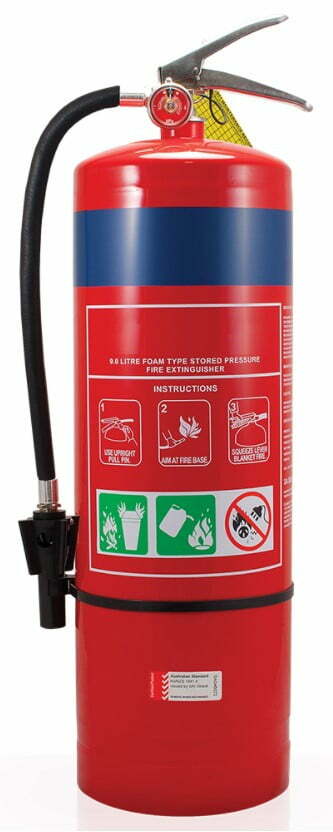Foam Fire Extinguishers
Foam fire extinguishers are an excellent solution if you run the risk of Class B fires involving flammable liquids, such as petrol and paint. Aqueous film forming foam (AFFF) is a synthetic foam concentrate consisting of fluorinated surfactants plus foam stabilisers which are mixed with water to form a foam. The fluorine-free extinguisher is a next-generation short-chain based extinguisher with superior performance.

How to Identify A Foam Fire Extinguisher?
Foam Fire Extinguishers are red cylinders with a blue band running all around the top. They also have a different nozzle compared to other extinguishers that are used to help mix the foam.
Where To Use A Foam Fire Extinguisher
AFFF fire extinguishers are suitable for use on common flammable liquid fires such as:
- Petrol
- Oil
- Paint
Foam fire extinguishers shouldn’t be placed in locations near electrical equipment. In the heat of the moment, someone may use the extinguisher without thinking about it and spray on live electrical equipment.
How Does A Foam Fire Extinguisher Work?
The Foam fire extinguisher works by providing a film on top of the fuel, starving the fire of oxygen. For class A fires not only does it remove the oxygen but also lowers the temperature thanks to the cooling effect from the water.

Foam Extinguisher Sizes

We stock two types of foam fire extinguisher
9.0ltr – Foam AFFF fire extinguisher.
9.0ltr – Fluorine-free foam fire extinguisher.
Advantages Of Foam Extinguishers
Foam provides an extended-lasting layer to control the fire after the extinguisher discharge is complete. It can also be used to form a vapour suppression barrier over flammable liquid spills. Our new fluorine-free foam breaks down around 97% after 14 days. Thus making it an even more environmentally friendly option.
Disadvantages Of Foam Extinguishers
A foam fire extinguisher is mostly water. therefore should not be used on Class E fires. The aqueous solution is corrosive and requires to be cleaned after use, particularly on painted surfaces. It is advised to not use foam extinguishers for class F fires.
Foam Extinguisher Testing
Fire extinguisher testing must happen every 12 months by a professional, per NZS 4503:2005. Extinguishers need to be inspected at least once every six months in environments deemed’ hostile’. A hostile environment could mean that your work type has more associated fire hazards than usual. Every Five years, fire extinguishers require a hydrostatic pressure test to make sure your device is operating effectively and recharged when an extinguisher is discharged. Foam fire extinguishers require additional testing every three years.
How To Use A Foam Fire Extinguisher
Like all other fire extinguishers, you need to remember the PASS-word. Pull the pin Aim at the base of the fire. Squeeze the handle. Sweep from side to side.



